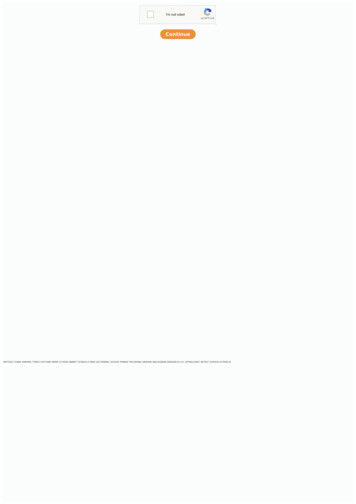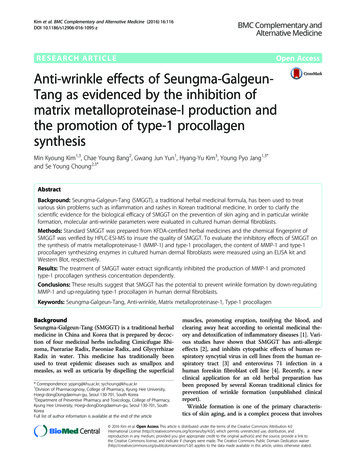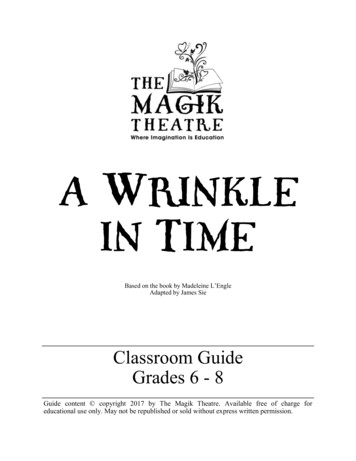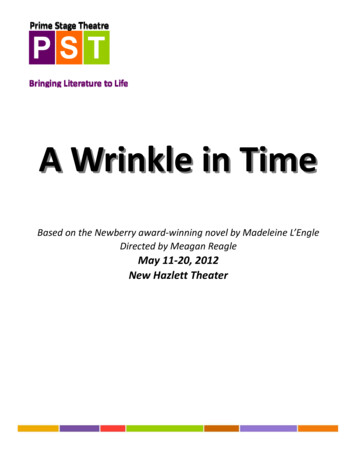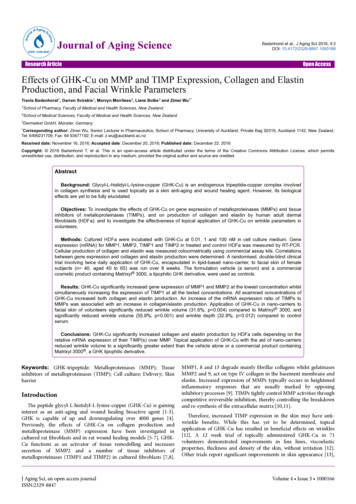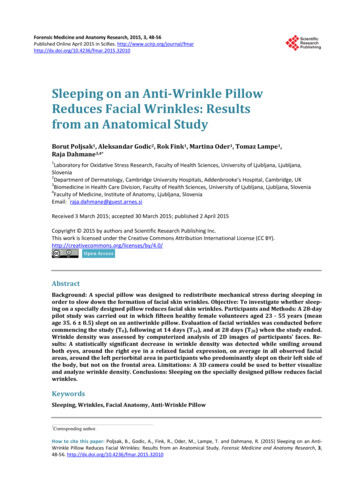
Transcription
Forensic Medicine and Anatomy Research, 2015, 3, 48-56Published Online April 2015 in SciRes. /10.4236/fmar.2015.32010Sleeping on an Anti-Wrinkle PillowReduces Facial Wrinkles: Resultsfrom an Anatomical StudyBorut Poljsak1, Aleksandar Godic2, Rok Fink1, Martina Oder1, Tomaz Lampe1,Raja Dahmane3,4*1Laboratory for Oxidative Stress Research, Faculty of Health Sciences, University of Ljubljana, Ljubljana,Slovenia2Department of Dermatology, Cambridge University Hospitals, Addenbrooke’s Hospital, Cambridge, UK3Biomedicine in Health Care Division, Faculty of Health Sciences, University of Ljubljana, Ljubljana, Slovenia4Faculty of Medicine, Institute of Anatomy, Ljubljana, Slovenia*Email: raja.dahmane@guest.arnes.siReceived 3 March 2015; accepted 30 March 2015; published 2 April 2015Copyright 2015 by authors and Scientific Research Publishing Inc.This work is licensed under the Creative Commons Attribution International License (CC tractBackground: A special pillow was designed to redistribute mechanical stress during sleeping inorder to slow down the formation of facial skin wrinkles. Objective: To investigate whether sleeping on a specially designed pillow reduces facial skin wrinkles. Participants and Methods: A 28-daypilot study was carried out in which fifteen healthy female volunteers aged 23 - 55 years (meanage 35. 6 8.5) slept on an antiwrinkle pillow. Evaluation of facial wrinkles was conducted beforecommencing the study (T0), following at 14 days (T14), and at 28 days (T28) when the study ended.Wrinkle density was assessed by computerized analysis of 2D images of participants’ faces. Results: A statistically significant decrease in wrinkle density was detected while smiling aroundboth eyes, around the right eye in a relaxed facial expression, on average in all observed facialareas, around the left periorbital area in participants who predominantly slept on their left side ofthe body, but not on the frontal area. Limitations: A 3D camera could be used to better visualizeand analyze wrinkle density. Conclusions: Sleeping on the specially designed pillow reduces facialwrinkles.KeywordsSleeping, Wrinkles, Facial Anatomy, Anti-Wrinkle Pillow*Corresponding author.How to cite this paper: Poljsak, B., Godic, A., Fink, R., Oder, M., Lampe, T. and Dahmane, R. (2015) Sleeping on an AntiWrinkle Pillow Reduces Facial Wrinkles: Results from an Anatomical Study. Forensic Medicine and Anatomy Research, 3,48-56. http://dx.doi.org/10.4236/fmar.2015.32010
B. Poljsak et al.1. IntroductionThe facial skin responds to repetitive contractions of underlying muscles while smiling, frowning, and otherphysical movements. Usually, by the mid-twenties, most people begin to notice faint lines on the forehead, between the eyebrows, in the nasolabial folds and the periorbital areas [1] [2]. Early wrinkles are seen at first during facial expression, whereas persistent wrinkles, such as crow’s feet, glabellar frown lines and forehead transverse lines, appear later [3]. Facial expressions are produced by 43 muscles, which can produce over 100,000variations [1]. The palpebral and orbital components of the orbicularis oculi muscle surround the pretarsal andpreseptal aspects and function essentially as the sphincter muscle of the eyelid, which is responsible for blinkingand gentle eye closure. Its direct antagonist is the Levator palpebrae muscle. Some of the fibres of the superiormedial orbital component function as depressors of the medial eyebrow, whereas the superior lateralorbital orbicularis acts partly as a depressor of the lateral eyebrow. Forceful mechanical pressure on the orbital component induces concentric folds emanating from the lateral canthus, resulting in lateral canthal lines, or “crow’sfeet”. The zygomaticus major muscle forms the angle of the mouth superiorly, laterally and posteriorly, in a similar manner as seen in laughing, smiling and chewing. The zygomaticus minor muscle functions as one of the lipelevators, and both contribute to the formation of the melolabial fold. Mechanical pressure on both zygomaticusmuscles produces synergistic effects in the periorbital region, which is accentuated by pressure on the orbitalorbicularis muscle, and all together contributes to the formation of radially oriented folds at the lateral cantus.The orbicularisoris is responsible for forceful lip closure and serves as a sphincter of the mouth. Pressure on thismuscle induces folds that radiate perpendicularly to the vermilion border. This muscle is partly an antagonist ofthe lip elevators. The lip depressors include the orbicularis oris, mentalis, depressor angulioris, depressorlabiiand platysma muscles. The levator labii superioris alaeque nasi muscle is a lip elevator and its contraction can,in some people, cause obliquely oriented wrinkles along the nasal dorsum and sidewall, after just 30 seconds ofmechanical pressure [4].Longitudinal studies confirm that persistent wrinkles evolve directly from temporary ones [5]. An imagebased method was developed which showed that a subjects’ unique pattern of persistent facial wrinkles observedduring a neutral expression at the age of 8 years was predicted by the pattern of temporary wrinkles observedwhile smiling [6]. Factors which contribute to facial wrinkle formation include genetic predisposition, environmental influences, habits, hyperdynamic facial expression, loss of underlying skeletal and soft tissue support,decreased skin elasticity, and gravitational force [7]. Underlying mechanical stress is an obligatory factor. If it isnot present, as seen on the dorsal forearms, wrinkles do not form regardless of photo damage severity. The lossof the skins mechanical property is significantly faster on sun-exposed than on sun-protected areas [8]. Persistent facial wrinkle formation thus depends on both the cumulative amount of mechanical stress and reduced skinelasticity caused by aging and photo damage due to previous sun exposure. Ultraviolet (UV)-induced skin damage is thus not a cause but an accelerator of wrinkle formation [1].Sleep lines are caused by repetitive and constant pressure of the face on a pillow during sleeping and bodyposition importantly contributes to their formation [9]. People sleep approximately eight hours per day and whensleeping on one side of the body (or on the stomach), temporary sleeping lines become permanent after sometime. Sleeping can cause irreversible damage to the dermis and adipose tissues in an individual and result in facial deformities. It exhibits long-term tension on the skin, which pushes or pulls the skin in a direction that isperpendicular to the direction of the muscles of the face. Gravitational force becomes very aggressive and causesthe muscles to elongate. Permanent sleeping wrinkles often fade in morning in young, although they may bevisible for several hours until the facial skin adopts its initial relaxed state. As we age, this interval prolongs,leading to permanently damaged soft tissue and permanent wrinkles.The aim of our study was to investigate to what extent sleeping contributed to formation of facial wrinklesand whether sleeping on the specially designed pillow reduced them. We adopted methods from the study ofBaek et al. to demonstrate that sleeping on the specially designed pillow reduced facial skin wrinkles [10].2. Materials and Methods2.1. ParticipantsA 28-day pilot study was carried out in which fifteen healthy female volunteers aged 23 - 55 years (mean age35.6 8.5) slept on our specially designed pillow. Inclusion criteria were that the volunteers were healthy Cau-49
B. Poljsak et al.casian women without pre-existing skin disease (including damaged skin, previous sunburn, tattoos, and scars),chronic diseases, pregnancy, or taking medication which could influence the skin response. Participants’ wrinkles were measured before they started sleeping on the anti-wrinkle pillow (baseline) (T0) and then two (T14) andfour (T28) weeks afterwards when the experiment ended. None of the subjects had had invasive or non-invasivefacial procedures in the past (surgical, laser, fillers, Botox, peelings). They were asked not to change any habits,which could influence the quality of the skin (e.g. sun exposure, extreme sport activities, alcohol and cigaretteconsumption, ingestion of antioxidants and food supplements, usage of cosmetics, etc.). No adverse reactionswere observed or reported during the study. Measurements were performed under controlled and identical environmental conditions for all participants. The ambient temperature was maintained at 21 C 3 C and the relative humidity in the range of 50% 8%. None of participants wore makeup and were allowed to relax on acomfortable diagnostic bed for some minutes before the pictures were taken. All pictures were taken between 12p.m. and 3 p.m. The study was conducted during the period from June to July 2013, according to the Declarationof Helsinki Principles and was approved by the National Medical Ethics Committee of the Republic of Slovenia.2.2. Properties of the Anti-Wrinkle PillowWe evaluated the specially-designed pillow to reduce and improve facial wrinkles/deformities while sleeping.Standard pillows exert pressure on an individual’s face when a user is lying in a prone position with the facepressed against a pillow, mostly on its central part. The pressure is thus generally unevenly dispersed and resultsin formation of the facial deformities and wrinkles, especially on the cheeks, around the eyes and the mouthwhere the pressure is highest (Figure 1(a)). The anti-wrinkle pillow was designed to redistribute pressure fromthe central face (the cheeks, eyes and mouth) to the chin and the forehead (Figure 1(b) and Figure 2). It has acentral hole with a centric wire to regulate its size to suspend the user’s face whilst sleeping and two differentsides, which enable the user to choose according to the length of his/her neck for a proper neck support (Figure2) [4].(a)(b)Figure 1. (a) and (b) Presentation of the force distribution on the face with standard and anti-wrinkle pillows. Redistribution of the pressure from delicate parts of the face to the chin and the forehead can beseen if sleeping on an anti-wrinkle pillow. The measurement of the pressure was done by mFLEX instrument that evaluates the interaction between a human body and the surface that supports it. (a) Standard pillow; (b) Anti-wrinkle pillow.50
B. Poljsak et al.Figure 2. The specially designed anti-wrinkle pillow. Legend: 1: central hole; 2: centric wire; 3: variable filling; 4 and 5: different sizes (fillings), which enable more/less neck support.2.3. Facial Wrinkles AssessmentEvaluation of facial wrinkles was conducted at baseline (T0), at two (T14) and at four (T28) weeks afterwards.Participants’ faces were photographed by 2D Image Analysis Skin CT computerized camera (Meizy BeautyEquipment Manufacturer, China) and photographs were analysed with the built analysing software. This analysing system of 2D images allows fast, contact-free, and direct measurement of the skin surface topography invivo and at high resolution. Severity of wrinkles was quantified as the wrinkle density (percentage of wrinklesper observed area), which was calculated by dividing the total wrinkle pixel area (marked with green dots andlines in Figure 3) by total pixels of the area of interest (outlined area in Figure 3) based on the default parameter settings from the manufacturer. All images were analysed by the red, green, and blue model (RGB), which isbased on three independent primary colours, and the value of each component strongly depends on the light intensity of the image. The RGB system was used to minimize errors caused by irregular light intensity of images.The computer-based image analysis was used to identify and quantify facial wrinkles, since it is less artefactprone and more accurate method than the commonly used silicon replica technique [11] [12].The surface of observed wrinkle areas (outlined with green dots/lines in Figure 3) on each subject’s image wasdefined by standardized facial landmarks: both lateral canthuses, alar fibro-fatty tissue of the nose and corners ofthe mouth. This standardized surface was then used to assess subjects’ images taken under same conditions inneutral and smiling facial expressions at T0, T14, and T28 (Figure 3). The analysis was based on the relativechange of facial wrinkles, since the relative change of wrinkles would reflect the efficiency of the anti-wrinklepillow, which would thus allow the interpretation of the results more accurately than absolute values, with whicheach individual should have their own reference value. Reference values were defined separately for each individual before sleeping on pillow.2.4. Statistical AnalysisPaired t-test analysis was conducted using R software program [13]. We analysed differences in wrinkle densities before commencing the study (T0), two (T14), and four (T28) weeks afterwards. We analysed five facial areasseparately (as described above) and all together.3. ResultsA statistically significant decrease in wrinkle density occurred 14 days of anti-wrinkle pillow use; around theright eye in neutral and smiling facial expressions, around the left eye whilst smiling and on average in all observed areas (p 0.05) (Table 1). Even greater differences were observed after 28 days (Table 2) but they werenot statistically significant when compared T14 and T28 (Table 3). All selected facial parameters showed statistically significant decrease in wrinkle densities after 28 days except the frontal area (p 5.38). Results alsoshowed that wrinkles decreased mostly around the right eye, the left eye while smiling and on average in all observed areas of the face (total area) regardless of the duration of the study (T14 and T28). The average reductionof wrinkles in total investigated area of the face (expressed as the density of wrinkles per observed skin surface)was approximately 7% after 14 days, and 12% after 28 days. We also further tested whether there was a statistical difference between the sleeping position (left vs. right side of the body) and facial wrinkle improvement in51
B. Poljsak et al.Figure 3. The face was divided into five observed wrinkle areas: around the right (a) and left eyes (b), frontal area (c); andboth nasolabial folds (d). Pictures (a), (b), (c) and (d) were taken in a neutral relaxed expression of participants’ faces (to assess persistent wrinkles), and a* and b* while smiling to assess temporary wrinkles. Five pictures of an each participant wereanalysed: one taken in a frontal view ((c) and (d)) and four in an oblique 45 view ((a), (a*), (b), (b*)). The program detectsthe total pixels of the wrinkle area (marked with green dots), and the wrinkle density was calculated as the percentage of totalpixels of the outlined area (marked with green lines).Table 1. Wrinkles density at the baseline and following 14 days of sleeping on a pillow at different anatomical regions of theface.T0T1495% confidence intervalMean of the 610.0005*5.782.259.313.530.0036*51.282.71 LowUpperFront46.2645.850.71 4.60Eye right50.6645.646.85Eye right smile56.0151.64Eye left52.26Eye left smileTotal areaLegend: T0—baseline; T14—after 14 days of using a pillow; *p 0.05.52
B. Poljsak et al.Table 2. Wrinkle density at the baseline and following 28 days of sleeping on a pillow at different anatomical regions of theface.T0T2895% confidence intervalMean of the differencesAverageAverageFront46.2647.35Eye right50.66Eye right smilet-valuep-valueLowUpper 0.71 3.151.72 140.889.402.600.0216*Eye left52.2645.926.921.7612.092.890.0124*Eye left smile65.2054.5711.714.2219.203.370.0049*Total area56.644.412.201.7615.462.690.01737*Legend: T0—baseline; T28—after 28 days of using a pillow; *p 0.05.Table 3. Wrinkle density after 14 and 28 days of sleeping on a pillow at different anatomical regions of the face.T14T2895% confidence intervalMean of the differencest-valuep-value0.94 1.650.1236 4.424.4201.0000 0.61 5.854.62 0.250.802245.854.23 1.499.951.600.133557.3554.572.78 5.317.920.430.674649.644.45.2 547.35 3 6.94Eye right45.6444.71/Eye right smile45.6444.71Eye left51.28Eye left smileTotal areaLegend: T14—after 14 days of using a pillow; T28—after 28 days of using a pillow; *p 0.05.neutral and smiling facial expressions after sleeping on the anti-wrinkle pillow for 28 days. To test this hypothesis, participants were divided into two groups, those who reportedly sleep predominantly either on the left or onthe right side of the body. Sleeping habits of participants were as follows: twelve participants reported that theysleep predominantly on the left or both sides of the body, six predominantly on the right or both sides, eleven onboth sides, three on their stomach, and one on her back (Table 4 and Table 5). Results did not reveal statistically significant reduction in wrinkle density in a neutral facial expression, however, wrinkle density decreasedaround the left periocular area in participants who claimed to sleep predominantly on their left (or both) side ofthe body while smiling, and the difference was statistically significant (Table 5) (p 0.0490). Finally, we investigated if sleeping position influences overall density of facial wrinkles. To test this hypothesis, participantswere divided into two groups, those who sleep predominantly on either side of their bodies and those who sleepon their backs and/or stomachs. Total wrinkle area was compared in both groups at time T0 and T28 and averageimprovement/reduction of facial wrinkles was evaluated (Table 6). Those participants who sleep on either sideof their bodies (left or right) (N 11) showed statistically significant reduction in total wrinkle improvement (p 0.0109) compared to those who sleep on their back (N 1) and stomach (N 3).4. DiscussionStegman postulated for the first time in his paper “Sleep Creases” published in 1987 the likely aetiology ofsleeping creases, which he observed to form diagonally on the cheeks and the lower face and vertically on theforehead [14]. It was noticed later that sleeping wrinkles can also manifest as the nasolabial folds and as “crow’sfeet” around the eyes. Stegman also noticed that sleeping wrinkles are different than wrinkles caused by sundamage, due to smoking, frowning or laughing, since they are caused by specific sleeping behaviour and become deepened over time if sleeping patterns do not change. His theory was later confirmed by Fulton and Gaminchi [15] and Sarifakioğlu et al. [9].53
B. Poljsak et al.Table 4. Comparison of sleeping position (left vs. right side of the body) and wrinkle improvement/reduction at the both periocular areas in a neutral facial expression after sleeping on an anti-wrinkle pillow for 28 days.ΔT (T0 T28)Left eyeΔT (T0 T28)Right eyeAverageAverageSleeping on the right orboth sides (N 6)5.836.66Sleeping on the left orboth sides (N 12)8.257.2595% confidence intervalMean of thedifferencest-valuep-value6.94 0.270.79416.060.4340.6721LowUpper 0.83 8.611 4.06Legend: ΔT—average change of wrinkles’ densities; *p 0.05.Table 5. Comparison of sleeping position (left vs. right side of the body) and wrinkle improvement/reduction at both periocular areas while smiling after sleeping on an anti-wrinkle pillow for 28 days.ΔT (T0 T28)Left eye smileΔT (T0 T28)Right eye smileAverageAverageSleeping on the right orboth side (N 6)9.333.33Sleeping on the left orboth side (N 12)14.586.0895% confidence intervalMean of thedifferencest-valuep-value24.80.0160.4513 18.8 5.6630.0490*LowUpper6 12.88.5 67.3Legend: ΔT—average change of the wrinkle density; *p 0.05.Table 6. Comparison of sleeping position (left/right side of the body vs. back/stomach) and total wrinkle improvement/reduction.Total wrinkleimprovementΔT (T0 T28)Sleeping on either sideΔT (T0 T28)Sleeping on back or stomachAverageAverage9.635.8Mean of thedifferences8.595% confidence intervalt-value p-valueLowUpper 67.3 18.8 5.66 0.0109*Legend: ΔT—change in average percentage of wrinkles; *p 0.05.According to Hillebrand et al., age at onset and rate of persistent facial wrinkles depend on both, the cumulative amount of mechanical stress (frequency of temporary wrinkles) and reduced skin elasticity due to cumulative harmful environmental influences, such as sun exposure [1]. The skin progressively loses its elasticity dueto decreased synthesis of procollagen I and III, reduced elastin gene expression in the dermis, and decreasedproliferative capacity of the skin cells and intercellular matrix synthesis [16] [17]. Considering that most peoplesleep about one third of their life, prolonged and repeated distortion of their facial skin will eventually lead topremature wrinkle formation. Nasolabial folds and wrinkles around periocular areas are particularly noticeableon mornings after waking up. The depth of wrinkles usually reduces during day because the gravity causes thecheeks to pull down the skin around the eyes thereby reducing wrinkles. However, continuous and repetitivepressure on the face during sleeping leads to formation of permanent wrinkles. Fulton and Gaminchi observedthat sleep lines were related to facial attachments of the superficial musculoaponeurotic system and recommended to release them with a carbon dioxide laser in order to achieve a good clinical outcome [15]. We presentan alternative solution to reduce sleep-related facial deformities and wrinkles while sleeping. Sleeping on a specially designed pillow resulted in significant decrease in wrinkle density. The average reduction in total investigated area of the face (expressed as the density of wrinkles per observed skin surface) was approximately 7%after 14 days, and 12% after 28 days (Table 1 and Table 2). Similar results were obtained by Beak et al., whodemonstrated that sleeping on pillowcases which contained copper-impregnated fibres, reduce depth of skinwrinkles by approximately 9% [10]. On the other hand, improvement in wrinkle density at frontal area of theface (the nasolabial folds and the forehead) could not be observed, although we expected deterioration of oblique wrinkles located unilaterally on the left and right side of the forehead, since the pillow was not designed torelease the pressure of the forehead. Two possible explanations would be that participants were too young and54
B. Poljsak et al.had too elastic skin and that evaluation was made hours after waking up when temporary wrinkles disappeared.Since evaluation of frontal pictures included the forehead and nasolabial folds together, the possible improvement in nasolabial folds and/or deterioration in forehead wrinkles could not be observed because we did notanalyse those two regions of the face separately. The further improvement in wrinkle density after sleeping on apillow from a 2nd week to a 4th week (comparison of T14 and T28) could also not be observed (Table 3), mostprobably because wrinkles become less noticeable already after few days of cessation of the pressure on delicateparts of the face and did not improve further. We also found in our study that those participants who weresleeping on either side of their bodies (left or right) showed statistically significant reduction in total wrinkledensity compared to those who were sleeping on their back and stomach. This could mean that people who sleeppredominantly on their left or right side of the body could benefit more from using the anti-wrinkle pillow compared to those who sleep predominantly on their back or stomach. Furthermore, wrinkle density improvedaround the left periorbital area in participants who reportedly sleep predominantly on their left side of the bodywhile smiling but not in relaxed facial expression. In those participants we demonstrated improvement of temporary wrinkles despite of their relatively young age when one does not expect dramatic decrease in skin elasticity and severe sun damage. This further supports the benefit of an anti-wrinkle pillow. We did not observe anycorrelation between reduction in wrinkle density and age of participants most likely because age differences ofour participants were too small to observe dramatic reduction in skin elasticity.5. ConclusionSleeping on the specially designed pillow results in a significant reduction of facial skin wrinkle density. Redistribution of the mechanical stress on the delicate areas of the face during sleep can significantly slow down therate and extent of facial wrinkles formation, especially in users who tend to sleep predominantly on sides of theirbodies. The anti-wrinkle pillow may represent an effective method to prevent sleeping wrinkles.AcknowledgementsAuthors would like to thank Florian Probst for his valuable comments. Pillows were donated by Maremico,d.o.o. The first author declares the following: Prof. Dr. Borut Poljsak is a consultant for the company Maremico,d.o.o. All other authors do not report any conflicts of interest. No grants or other financial assistance was provided for the study.References[1]Hillebrand, G.G., Liang, Z., Yan, X. and Yoshii, T. (2010) New Wrinkles on Wrinkling: An 8-Year Longitudinal Studyon the Progression of Expression Lines into Persistent Wrinkles. British Journal of Dermatology, 162, 10.09709.x[2]Puizina-Ivic, N. (2008) Skin Aging. Acta Dermatovenerologica Alpina, Panonica et Adriatica, 17, 47-52.[3]Miyamoto, K. and Hillebrand, G.G. (2007) The Influence of Facial Expression on the Age-Dependent Changes in Facial Wrinkling. Journal of Society of Cosmetic Science, 58, 206-207.[4]Poljsak, B., Godic, A., Lampe, T. and Dahmane, R. (2012) The Influence of the Sleeping on the Formation of FacialWrinkles. Journal of Cosmetic and Laser Therapy, 14, 133-138. illebrand, G.G. and Demirli, R. (2009) Method and Apparatus for Realistic Simulation of Wrinkle Aging and DeAging. U.S. Patent Application 20090028380A1.[6]Hillebrand, G.G., Levine, M.J. and Miyamoto, K. (2001) The Age-Dependent Changes in Skin Condition in AfricanAmericans, Caucasians, East Asians, Indian Asians and Latinos. IFSCC Magazine, 4, 259-266.[7]Zimbler, M.S., Kokoska, M.S. and Thomas, J.R. (2001) Anatomy and Pathophysiology of Facial Aging. Facial PlasticSurgery Clinics of North America, 9, 179-187.[8]Jemed, G.B.E., Selvaag, E., Agren, M. and Wulf, H.C. (2001) Measurement of the Mechanical Properties of Skin withBallistometer and Suction Cup. Skin Research and Technology, 7, .70211.x[9]Sarifakioğlu, N., Terzioğlu, A., Ates, L. and Aslan, G. (2004) A New Phenomenon: “Sleep Lines” on the Face. Scandinavian Journal of Plastic and Reconstructive Surgery and Hand Surgery, 38, 755
B. Poljsak et al.[10] Baek, J.H., Yoo, M.A., Koh, J.S. and Borkow, G. (2012) Reduction of Facial Wrinkles Depth by Sleeping on CopperOxide-Containing Pillowcases: A Double Blind, Placebo Controlled, Parallel, Randomized Clinical Study. Journal ofCosmetic Dermatology, 11, 193-200. [11] Friedman, P.M., Skover, G.R., Payonk, G., Kauvar, A.N. and Geronemus, R.G. (2002) 3D In-Vivo Optical Skin Imaging for Topographical Quantitative Assessment of Non-Ablative Laser Technology. Dermatologic Surgery, 28, 199204.[12] Jacobi, U., Chen, M., Frankowski, G., Sinkgraven, R., Hund, M., Rzany, B., et al. (2004) In Vivo Determination ofSkin Surface Topography Using an Optical 3D Device. Skin Research and Technology, 10, .00075.x[13] R Development Core Team (2012) R: A Language and Environment for Statistical Computing. R Foundation for Statistical Computing, Vienna. http://www.R-project.org/[14] Stegman, S.J. (1987) Sleep Creases. American Journal of Cosmetic Surgery, 4, 277-280.[15] Fulton, J.E. and Gaminchi, F. (1999) Sleep Lines. Dermatologic Surgery, 25, 8073.x[16] Varani, J., Warner, R.L., Gharaee-Kermani, M., Phan, S.H., Kang, S., Chung, J.H., et al. (2000) Vitamin A Antagonizes Decreased Cell Growth and Elevated Collagen-Degrading Matrix Metalloproteinases and Stimulates CollagenAccumulation in Naturally Aged Human Skin. Journal of Investigative Dermatology, 114, .00902.x[17] Poljsak, B., Dahmane, R. and Godic, A. (2012) Intrinsic Skin Aging: The Role of Oxidative Stress. Acta Dermatovenerologica Alpina, Panonica et Adriatica, 21, 33-36.56
time. Sleeping can cause irreversible damage to the dermis and adipose tissues in an individual and result in fa- . The anti-wrinkle pillow was designed to redistribute pressure from the central face (the cheeks, eyes and mouth) to the chin and the forehead (Figure 1(b) and Figure 2). It has a . contact-free, and direct measurement of the .
